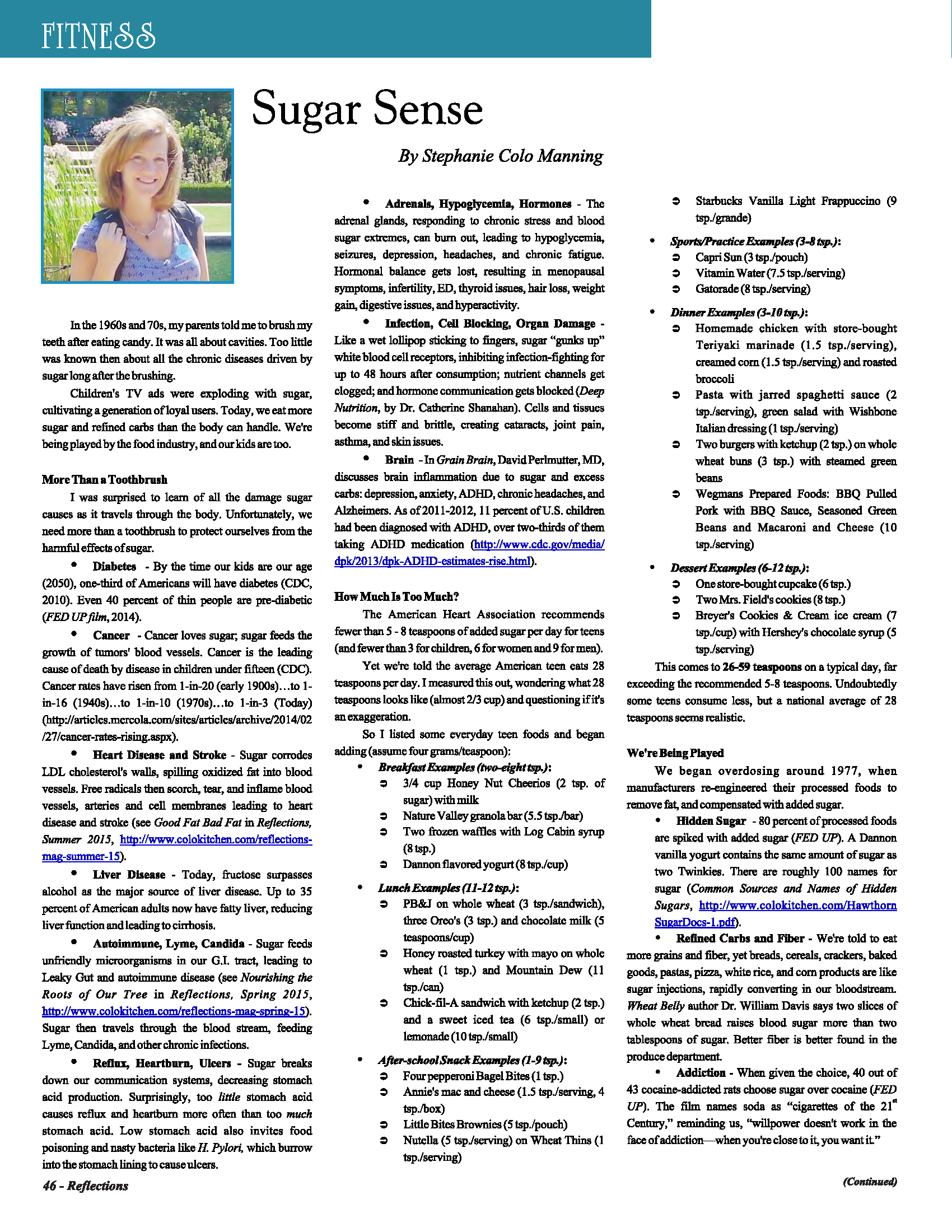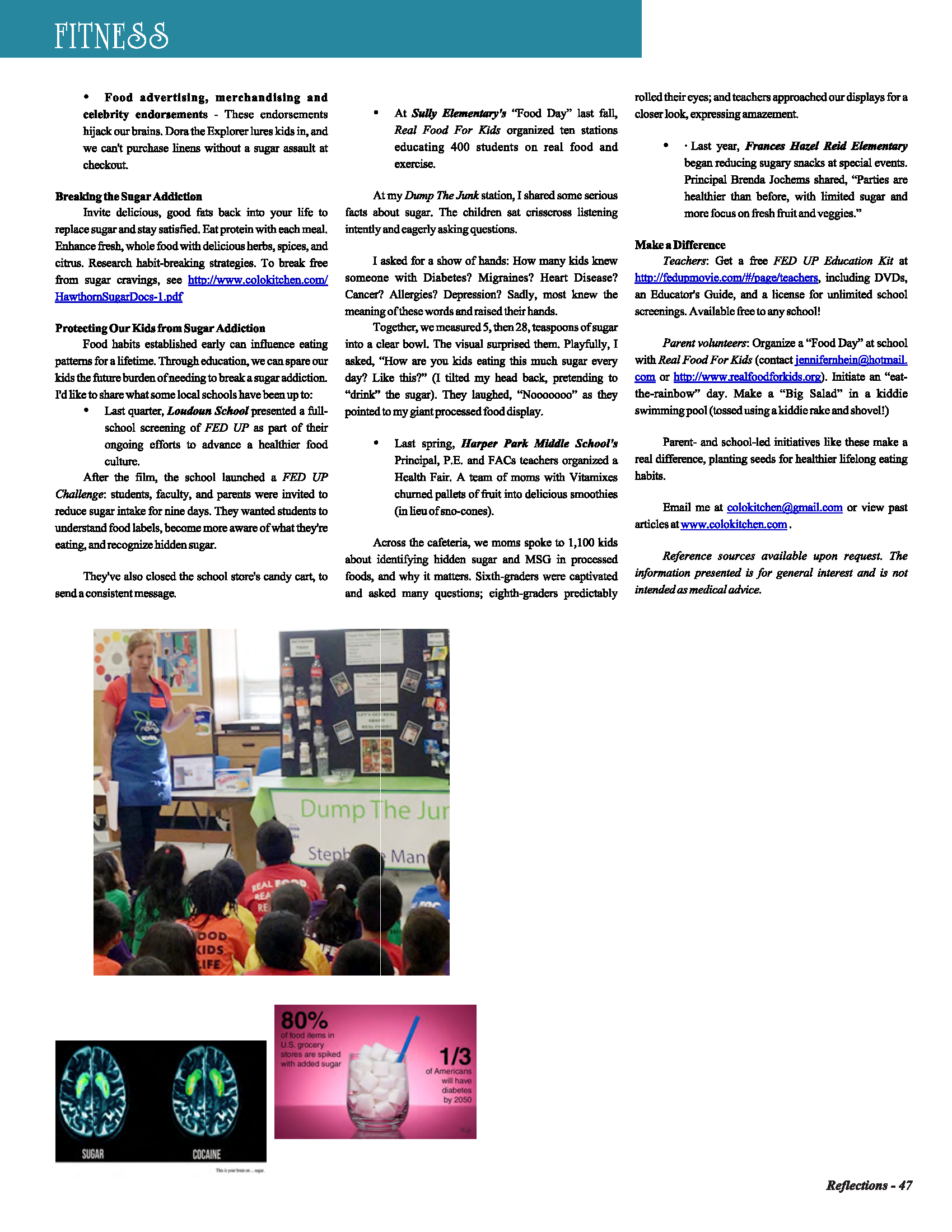By Stephanie Colo Manning
In the 1960s and 70s, my parents told me to brush my teeth after eating candy. It was all about cavities. Too little was known then about all the chronic diseases driven by sugar long after the brushing.
Children’s TV ads were exploding with sugar, cultivating a generation of loyal users. Today, we eat more sugar and refined carbs than the body can handle. We’re being played by the food industry, and our kids are too.
More Than a Toothbrush
I was surprised to learn of all the damage sugar causes as it travels through the body. Unfortunately, we need more than a toothbrush to protect ourselves from the harmful effects of sugar.
- Diabetes By the time our kids are our age (2050), one-third of Americans will have diabetes (CDC, 2010). Even 40 percent of thin people are pre-diabetic (FED UP film, 2014).
- Cancer Cancer loves sugar; sugar feeds the growth of tumors’ blood vessels. Cancer is the leading cause of death by disease in children under fifteen (CDC). Cancer rates have risen from 1-in-20 (early 1900s)…to 1-in-16 (1940s)…to 1-in-10 (1970s)…to 1-in-3 (Today) (http://articles.mercola.com/sites/articles/archive/2014/02/27/cancer-rates-rising.aspx)
- Heart Disease & Stroke Sugar corrodes LDL cholesterol’s walls, spilling oxidized fat into blood vessels. Free radicals then scorch, tear, and inflame blood vessels, arteries and cell membranes leading to heart disease and stroke (see Good Fat Bad Fat in Reflections, Summer 2015).
- Liver Disease Today, fructose surpasses alcohol as the major source of liver disease. Up to 35 percent of American adults now have fatty liver, reducing liver function and leading to cirrhosis.
- Autoimmune, Lyme, Candida Sugar feeds unfriendly microorganisms in our G.I. tract, leading to Leaky Gut and autoimmune disease (see Nourishing the Roots of Our Tree in Reflections, Spring 2015). Sugar then travels through the blood stream, feeding Lyme, Candida, and other chronic infections.
- Reflux, Heartburn, Ulcers Sugar breaks down our communication systems, decreasing stomach acid production. Surprisingly, too little stomach acid causes reflux and heartburn more often than too much stomach acid. Low stomach acid also invites food poisoning and nasty bacteria like H. Pylori, which burrow into the stomach lining to cause ulcers.
- Adrenals, Hypoglycemia, Hormones The adrenal glands, responding to chronic stress and blood sugar extremes, can burn out, leading to hypoglycemia, seizures, depression, headaches, and chronic fatigue. Hormonal balance gets lost, resulting in menopausal symptoms, infertility, ED, thyroid issues, hair loss, weight gain, digestive issues, and hyperactivity.
- Infection, Cell Blocking, Organ Damage Like a wet lollipop sticking to fingers, sugar “gunks up” white blood cell receptors, inhibiting infection-fighting for up to 48 hours after consumption; nutrient channels get clogged; and hormone communication gets blocked (Deep Nutrition, by Dr. Catherine Shanahan). Cells and tissues become stiff and brittle, creating cataracts, joint pain, asthma, and skin issues.
- Brain In Grain Brain, David Perlmutter, MD, discusses brain inflammation due to sugar and excess carbs: depression, anxiety, ADHD, chronic headaches, and Alzheimers. As of 2011-2012, 11 percent of U.S. children had been diagnosed with ADHD, over two-thirds of them taking ADHD medication (http://www.cdc.gov/media/dpk/2013/dpk-ADHD-estimates-rise.html).
How Much Is Too Much?
The American Heart Association recommends fewer than 5-8 teaspoons of added sugar per day for teens (and fewer than 3 for children, 6 for women and 9 for men.)
Yet we’re told the average American teen eats 28 teaspoons per day. I measured this out, wondering what 28 teaspoons looks like (almost 2/3 cup!) and questioning if it’s an exaggeration.
So I listed some everyday teen foods and began adding (assume 4 grams/teaspoon):
- Breakfast Examples (2-8 tsp):
- 3/4 cup Honey Nut Cheerios (2 tsp of sugar) with milk
- Nature Valley granola bar (5.5 tsp/bar)
- Two frozen waffles with Log Cabin syrup (8 tsp)
- Dannon flavored yogurt (8 tsp/cup)
- Lunch Examples (11-12 tsp):
- PB&J on whole wheat (3 tsp/sandwich), three Oreo’s (3 tsp) and chocolate milk (5 teaspoons/cup)
- Honey roasted turkey with mayo on whole wheat (1 tsp) and Mountain Dew (11 tsp/can)
- Chick-fil-A sandwich with ketchup (2 tsp) and a sweet iced tea (6 tsp/small) or lemonade (10 tsp/small)
- After-school Snack Examples (1-9 tsp):
- Four pepperoni Bagel Bites (1 tsp)
- Annie’s mac & cheese (1.5 tsp/serving, 4 tsp/box)
- Little Bites Brownies (5 tsp/pouch)
- Nutella (5 tsp/serving) on Wheat Thins (1 tsp/serving)
- Starbucks Vanilla Light Frappuccino (9 tsp/grande)
- Sports/Practice Examples (3-8 tsp):
- Capri Sun (3 tsp/pouch)
- Vitamin Water (7.5 tsp/serving)
- Gatorade (8 tsp/serving)
- Dinner Examples (3-10 tsp):
- Homemade chicken with store-bought Teriyaki marinade (1.5 tsp/serving), creamed corn (1.5 tsp/serving) and roasted broccoli
- Pasta with jarred spaghetti sauce (2 tsp/serving), green salad with Wishbone Italian dressing (1 tsp/serving)
- Two burgers with ketchup (2 tsp) on whole wheat buns (3 tsp) with steamed green beans
- Wegmans Prepared Foods: BBQ Pulled Pork with BBQ Sauce, Seasoned Green Beans and Macaroni & Cheese (10 tsp/serving)
- Dessert Examples (6-12 tsp):
- One store-bought cupcake (6 tsp)
- Two Mrs. Field’s cookies (8 tsp)
- Breyer’s Cookies & Cream ice cream (7 tsp/cup) with Hershey’s chocolate syrup (5 tsp/serving)
This comes to 26-59 teaspoons on a typical day, far exceeding the recommended 5-8 teaspoons. Undoubtedly some teens consume less, but a national average of 28 teaspoons seems realistic.
We’re Being Played
We began overdosing around 1977, when manufacturers re-engineered their processed foods to remove fat, and compensated with added sugar.
- Hidden Sugar 80 percent of processed foods are spiked with added sugar (FED UP). A Dannon vanilla yogurt contains the same amount of sugar as two Twinkies. There are roughly 100 names for sugar (Common Sources and Names of Hidden Sugars, http://www.colokitchen.com/HawthornSugarDocs-1.pdf).
- Refined Carbs and Fiber We’re told to eat more grains and fiber, yet breads, cereals, crackers, baked goods, pastas, pizza, white rice, and corn products are like sugar injections, rapidly converting in our bloodstream. Wheat Belly author Dr. William Davis says two slices of whole wheat bread raises blood sugar more than two tablespoons of sugar. Better fiber is better found in the produce department.
- Addiction When given the choice, 40 out of 43 cocaine-addicted rats choose sugar over cocaine (FED UP). The film names soda as “cigarettes of the 21st Century,” reminding us, “willpower doesn’t work in the face of addiction… when you’re close to it, you want it.”
- Food advertising, merchandising and celebrity endorsements hijack our brains. Dora the Explorer lures kids in, and we can’t purchase linens without a sugar assault at checkout.
Breaking the Sugar Addiction
Invite delicious, good fats back into your life to replace sugar and stay satisfied. Eat protein with each meal. Enhance fresh, whole food with delicious herbs, spices, and citrus. Research habit-breaking strategies. To break free from sugar cravings, see http://www.colokitchen.com/HawthornSugarDocs-1.pdf
Protecting Our Kids from Sugar Addiction
Food habits established early can influence eating patterns for a lifetime. Through education, we can spare our kids the future burden of needing to break a sugar addiction. I’d like to share what some local schools have been up to:
- Last quarter, Loudoun School presented a full-school screening of FED UP as part of their ongoing efforts to advance a healthier food culture.
After the film, the school launched a FED UP Challenge: students, faculty, and parents were invited to reduce sugar intake for nine days. They wanted students to understand food labels, become more aware of what they’re eating, and recognize hidden sugar.
They’ve also closed the school store’s candy cart, to send a consistent message.
- At Sully Elementary’s “Food Day” last fall, Real Food For Kids organized ten stations educating 400 students on real food and exercise.
At my Dump The Junk station, I shared some serious facts about sugar. The children sat criss-cross-apple-sauce, listening intently and eagerly asking questions.
I asked for a show of hands: How many kids knew someone with Diabetes? Migraines? Heart Disease? Cancer? Allergies? Depression? Sadly, most knew the meaning of these words and raised their hands.
Together, we measured 5, then 28, teaspoons of sugar into a clear bowl. The visual surprised them. Playfully, I asked, “How are you kids eating this much sugar every day? Like this?” (I tilted my head back, pretending to “drink” the sugar). They laughed, “Nooooooo” as they pointed to my giant processed food display.
- Last spring, Harper Park Middle School’s Principal, P.E. and FACs teachers organized a Health Fair. A team of moms with Vitamixes churned pallets of fruit into delicious smoothies (in lieu of sno-cones).
Across the cafeteria, we moms spoke to 1,100 kids about identifying hidden sugar and MSG in processed foods, and why it matters. Sixth-graders were captivated and asked many questions; eighth-graders predictably rolled their eyes; and teachers approached our displays for a closer look, expressing amazement.
- Last year, Frances Hazel Reid Elementary began reducing sugary snacks at special events. Principal Brenda Jochems shared, “Parties are healthier than before, with limited sugar and more focus on fresh fruit and veggies.”
Make a Difference
Teachers: Get a free FED UP Education Kit at http://fedupmovie.com/#/page/teachers, including DVDs, an Educator’s Guide, and a license for unlimited school screenings. Available free to any school!
Parent volunteers: Organize a “Food Day” at school with Real Food For Kids (contact http://www.realfoodforkids.org). Initiate an “eat-the-rainbow” day. Make a “Big Salad” in a kiddie swimming pool (tossed using a kiddie rake and shovel!)
Parent- and school-led initiatives like these make a real difference, planting seeds for healthier lifelong eating habits.
Stephanie Colo Manning holds a Master of Science degree in Holistic Nutrition. The information presented has not been evaluated by the FDA and is not intended to diagnose, treat, prevent, or cure any disease. References available upon request.


